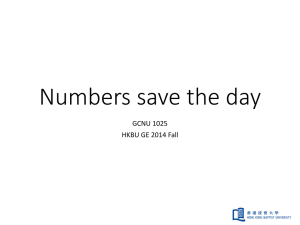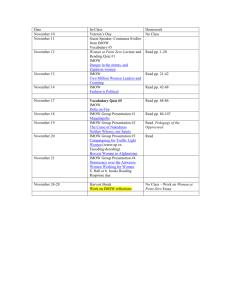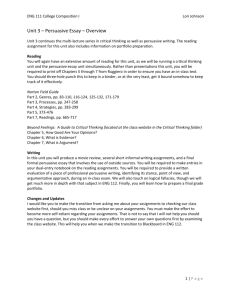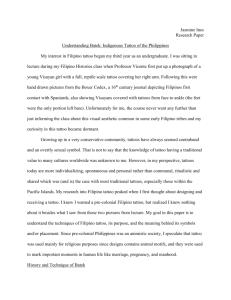ANT 314: Anthropology of Sex and Gender Diversity
advertisement
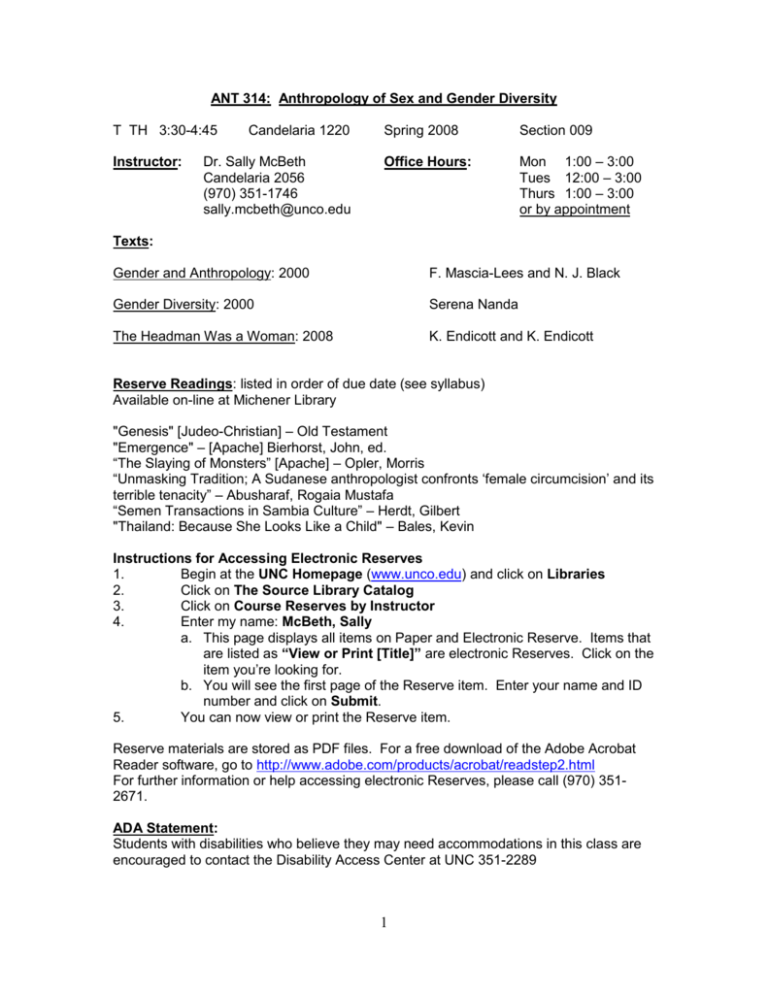
ANT 314: Anthropology of Sex and Gender Diversity T TH 3:30-4:45 Instructor: Candelaria 1220 Dr. Sally McBeth Candelaria 2056 (970) 351-1746 sally.mcbeth@unco.edu Spring 2008 Section 009 Office Hours: Mon 1:00 – 3:00 Tues 12:00 – 3:00 Thurs 1:00 – 3:00 or by appointment Texts: Gender and Anthropology: 2000 F. Mascia-Lees and N. J. Black Gender Diversity: 2000 Serena Nanda The Headman Was a Woman: 2008 K. Endicott and K. Endicott Reserve Readings: listed in order of due date (see syllabus) Available on-line at Michener Library "Genesis" [Judeo-Christian] – Old Testament "Emergence" – [Apache] Bierhorst, John, ed. “The Slaying of Monsters” [Apache] – Opler, Morris “Unmasking Tradition; A Sudanese anthropologist confronts ‘female circumcision’ and its terrible tenacity” – Abusharaf, Rogaia Mustafa “Semen Transactions in Sambia Culture” – Herdt, Gilbert "Thailand: Because She Looks Like a Child" – Bales, Kevin Instructions for Accessing Electronic Reserves 1. Begin at the UNC Homepage (www.unco.edu) and click on Libraries 2. Click on The Source Library Catalog 3. Click on Course Reserves by Instructor 4. Enter my name: McBeth, Sally a. This page displays all items on Paper and Electronic Reserve. Items that are listed as “View or Print [Title]” are electronic Reserves. Click on the item you’re looking for. b. You will see the first page of the Reserve item. Enter your name and ID number and click on Submit. 5. You can now view or print the Reserve item. Reserve materials are stored as PDF files. For a free download of the Adobe Acrobat Reader software, go to http://www.adobe.com/products/acrobat/readstep2.html For further information or help accessing electronic Reserves, please call (970) 3512671. ADA Statement: Students with disabilities who believe they may need accommodations in this class are encouraged to contact the Disability Access Center at UNC 351-2289 1 Catalogue Description: Study biologically and culturally determined gender role differences by comparing sexrelated behavior in a variety of cultures. Purpose of Course / Goals and Objectives: This course explores the construction of gender and sex in a variety of the world’s societies. It focuses on sex and gender as fundamental aspects of the human experience and as analytical constructs. On completion of the course, students will have gained knowledge of gender-based systems of social classification in non-Western societies, and acquired a knowledge of the ways in which gender impacts on the lives of women and men throughout the world. The goals and objectives of this course for the student are as follows: 1. to become aware of and knowledgeable about the essential role played by gender in all human societies; this means that we will draw on the historical framework, methodology, and research findings of various relevant disciplines; this course is broad in scope and will integrate various perspectives; the interrelation of knowledge will be stressed 2. to critically view the multiple ways in which gender is elaborated on in a variety of social and cultural constructs; this means that students will identify issues involved in human welfare and survival and foster cross-cultural understanding 3. demonstrate a critical ability to understand and engage in on-going theoretical debates about gender; thus I encourage critical and independent thought 4. demonstrate grade-level writing and communication skills; produce scholarship This course is divided into FOUR sections: First is Origins: Nature-Nurture, searching for the essence of a gendered humanity (followed by quiz/exam #1). Second is Anthropological Theories of gender (followed by exam #2). Third is Cross-Cultural Case Studies on sex roles and sexual practices (followed by exam #3). Fourth is Gender Diversity/Gender Bending (followed by exam #4). "NAMASTE" Nama means "bow," as means "I," and te means "you." Literally: I bow to you. It is a Hindu/Sanskrit gesture and greeting. Namaste represents the belief that there is a spark within each of us that is located in the heart chakra. The gesture pays homage to the inner light in all living things. The hands are placed together at the heart chakra, and the head is bowed. It is a gesture of friendship, kindness, hospitality, and appreciation. We will use this gesture and word at the beginning and end of each class, out of respect for each other. It can also be used in class discussions, when there are differences of opinion, or if students are not respecting their professor or other students in the class. 2 Course Requirements: 100 pts. (20%) Attendance, Reading Notes, In-class Exercises, Discussion, and Participation I will take attendance nearly every day—to keep you motivated to be here so late in the afternoon. Most of these “attendance points” will be in the form of in-class exercises (some, but not all) are listed in syllabus. For each of the 5 RESERVE READINGS [note: Genesis, Emergence, and Batek (p. 28) will be counted as one assignment] listed on page 1 of syllabus AND in syllabus as [+ reading notes], you are required to write about one page (typed; 12 font) about the article or story. This should include 1) synopsis of CONTENT as well as 2) your REACTIONS. These “reading notes” will be collected on the day of the assigned reading. They are designed to generate class discussion and so do not turn them into my mailbox; I will not accept them as late assignments except in the case of documented illness or conflicts you let me know of in advance. These reading notes are required; they are not optional. There are also 5 OTHER ASSIGNMENTS required: (1) sex id profile, (2) testosterone/estrogen summary (3) Welch Photography, (4) Mizuko Kuyo, and (5) Middle East: Afghanistan. The above 10 writing assignments are worth 5 points each (=50 points). If you are not in class or do not hand in these assignments, you will get a zero. Additionally there will be group and individual in-class assignments (and/or quizzes if I sense you are not doing the reading) based on reading for the day, reactions to films viewed in-class, etc. Some will be posted on BLACKBOARD. The above random collection ≥ 60 points (thus some extra credit). If you are not in class or do not hand in these assignments, you will get a zero. 50 pts. (10%) The Headman Was a Woman paper due on April 8 50 pts. (10%) Quiz/Exam #1: Short Answer/Identification on Jan. 31 100 pts. (20%) Exam #2: Essay/Identification on Feb. 26 100 pts. (20%) Exam #3: Essay/Identification on April 10 100 pts. (20%) Exam #4: Essay/Identification on May (Monday) of Finals Week: 1:30 – 4:00 500 pts. TOTAL Totals A = 500 – 450 (100-90%) B = 449 – 400 (89-80%) 3 C = 399 - 350 D = 349 - 300 (79-70%) (69-60%) Tentative Course Outline and Assignments Be sure to look ahead; reading assignments are due on day listed; bring books/articles/reading notes to class Do not turn in ANY assignments on pages torn from a spiral notebook Please turn off and put away cell phones (except for emergency situations) In-class exercises and reading notes cannot be made up, except for documented illness or conflicts you notify me of in advance. Week #1 Jan. 15 INTRODUCTION Introduction to course and course requirements (+ “sex” exercise) Jan. 17 ORIGINS: The “science” of sex An introduction to gender and the biology of sex (XX, XY, and Intersex). Check out: Intersex Society of North America Web Site http://www.isna.org/ and “When Gender Isn’t a Given” http://www.nytimes.com/2004/09/19/fashion/19INTE.html Week #2 Origins: The Case for Nature: aka Biological Determinism, Essentialist Position The Case for Nature Assignment: do an Internet search on testosterone and estrogen. Summarize (in one page) the effects (including 2ndary sex characteristics) of testosterone and estrogen. In-class group exercise. Colapinto case study. Jan. 22 Jan. 24 SEX ID and Sexualities: homo— hetero—, bisex— Assignment: Go to http://www.bbc.co.uk/science/humanbody/sex/results.shtml and complete your sex i.d. profile. Print it out and bring it to class; NOTE 1mm=0.0393701 inches. Check out: “Why is a woman’s brain smaller than a man’s?” http://boards.askmen.com/viewtopic.php?p=360728 and Straight, Gay or Lying? Bisexuality Revisited. Search the title on-line— Interesting NY Times article. Week #3 Origins: The Case for Nurture: aka Cultural Determinism, Constructionist Position The Case for Nurture Assignment: Gender and Anthropology Ch. 1; Reserve Readings: "Genesis" [Judeo-Christian]; "Emergence" [Apache]; Batek Origin Story (pp. 27-28) [+reading notes; about 1 ½ page total for 3 creation narratives]. Group project on "gendered" creation narratives and the "case" for nurture. Bring a current magazine to class. Jan. 29 Jan. 31 Exam/Quiz #1 4 Week #4 Feb. 5 THEORIES OF GENDER Evolutionary Theories Assignment: Gender and Anthropology Ch. 2-3 [Note: Chapter 3 does not (in my opinion) adequately discuss Evolutionary Theory—please read it, but lecture will be much more focused]; in-class exercise. Feb. 7 Psychological Theories Assignment: Gender and Anthropology Ch. 4; Reserve Reading: “The Slaying of Monsters” [+reading notes]; in-class exercise Week #5 Feb. 12 Materialist Theories Assignment: Gender and Anthropology Ch. 5; in-class exercise Feb. 14 Structuralist Theories Assignment: Gender and Anthropology Ch. 6; in-class exercise Week #6 Feb. 19 Feb. 21 Week #7 Feb. 26 Feb. 28 Week #8 March 4 March 6 Discourse Analysis and the Reflexive Approach Assignment: Gender and Anthropology Ch. 7-9; in-class exercise Theories: summary and questions Exam #2: identification and essay Please bring a small (8.5 x 7) BLUE BOOK GENDERED CROSS-CULTURAL CASE STUDIES Male and Female Puberty Rites: an Introduction to ‘blood magic’ Female Puberty Rites with a focus on Female Circumcision [Africa] film: “Female Circumcision” Assignment: Reserve Reading “Unmasking Tradition: a Sudanese anthropologist confronts…" (Abusharaf) [+reading notes]. Female Circumcision continued Go to: http://www.pulitzer.org/year/1996/feature-photography/works/ Assignment: write a one page "reaction" paper to the photos presented here, with a focus on what you think Welsh's motives were in taking these award-winning photos. 5 Week #9 March 11 March 13 Male Puberty Rites with a focus on New Guinea [Sambia] Assignment: Reserve Reading: “Semen Transactions in Sambia Culture” (Herdt) [+reading notes]. film: “Guardians of the Flute” (55 min.); in-class exercise SPRING BREAK Week #10 March 25 Sexual Exploitation with a focus on Southeast Asia Assignment: Reserve Reading: "Thailand: Because She Looks Like a Child" (Bales) [+reading notes]. March 27 film: "Anonymously Yours"; in-class exercise Week #11 April 1 April 3 Week #12 April 8 Gendered in Japan: Geishas, Male Host Bars, and Mizuko Kuyo Assignment: Read either "Aborted Women: A Japanese Perspective" at http://www.pregnantpause.org/aborted/japview.htm or "Pro-Choice Connection: Mizuko Kuyo" at http://www.prochoiceconnection.com/psc05.html [+reading notes] A little on the Middle East and summary and questions Assignment: Read: “The Day the Music Died” [+reading notes] at http://www.now.org/nnt/03-98/taliban.html Check out: http://www.rawa.org/index.php HIV AIDS; Batek paper due (see syllabus p. 7) April 10 Exam #3: identification and essay. Please bring a small (8.5 x 7) BLUE BOOK Week #13 April 15 GENDER DIVERSITY North American Indians film: “Two Spirit People”; in-class exercise Assignment: Gender Diversity pp. 1-9. Ch. 1 April 17 India Assignment: Gender Diversity Ch. 2; in-class exercise Week #14 April 22 Brazil film excerpt “All about My Mother.” Assignment: Gender Diversity Ch. 3 6 April 24 Week #15 April 29 Polynesia film: “Paradise Bent.” (50 min.) Assignment: Gender Diversity Ch. 4 Thailand and the Philippines film: “Ladyboys” Assignment Gender Diversity Ch. 5-7 May 1 Gender Diversity: summary and questions Week #16 May 5 1:30 – 4:00 Exam #4: identification and essay; Monday of Finals Week Please bring a small (8.5 x 7) BLUE BOOK Requirements for Paper on The Headman Was a Woman % of course grade: Length: Due Date: 10% 4-5 pages (do not exceed 5 pages, 12 font) April 8, 2008 You will be graded primarily on the quality of your essay’s content (substance and creativity), and that I can tell that you have read the materials (cite some page numbers in parentheses). I want your essay to reflect an understanding of Batek values, especially as concern gender equality. Batek culture is a gender egalitarian society—neither sex believe themselves to be superior to the other, and both share in contributions to subsistence. You may want to read/skim Chapter 7 before beginning your reading. A. Begin your essay (about ½ page) discussing who the Batek are, where they live, and how they support themselves (mid 1970s). B. Then choose ONE of the prompts below and develop your essay. C. Conclude with your thoughts and reflections on this ethnography (about ½ page). 1. PERSONA: Take on the persona of a Batek male or female. You can give yourself a name, age, and personality. Describe your life from birth to however old your persona is. What do you believe is in store for your future? 2. VALUES and CHANGE: Examine the values of Batek culture, with a focus on gender equality in the mid 1970s. Describe and comment on these values in detail. Compare life as described in the mid 1970s with that of the 21st century. How is Batek life better? How is it worse? 3. IMAGINE: that in the U.S. we raised our children with a Batek world view. World view refers to the framework of ideas and beliefs through which an individual interprets the world and interacts in it. Even though our economies are vastly different, what changes (positive and/or negative) would result in the ways that children would be raised? How would their lives as adults be different? Would raising our children in this way be conceivable in 21st century America? 4. WRITE your own essay question and answer it. This prompt MUST be cleared with me no later than April 1. 7 8



